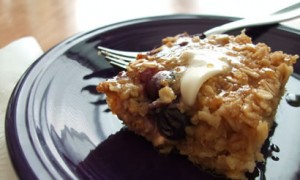 These baked oatmeal squares are easy to make, and can be topped or filled with any fruit you like. When serving these, for an extra special touch – top each square with a pat of real butter and a light drizzle of maple syrup.
These baked oatmeal squares are easy to make, and can be topped or filled with any fruit you like. When serving these, for an extra special touch – top each square with a pat of real butter and a light drizzle of maple syrup.
- 2 cups, uncooked, thick-rolled oats
- 2 Tablespoons spelt, whole wheat, OR buckwheat flour (freshly ground is preferred)
- 1 cup buttermilk (or 1 Tbsp. raw apple-cider vinegar + enough raw milk to = 1 cup)
- 2 large eggs
- 4 Tablespoons pure maple syrup
or raw honey
- 1/3 cup unsweetened applesauce
- 1/2 teaspoon vanilla extract (optional)
- 1/4 teaspoon cinnamon, or more to taste (optional)
- 1/2 teaspoon sea salt
- 1 teaspoon baking powder
- 1/2 to 3/4 cup fresh or frozen blueberries (or some other berries/fruit)
8 to 12 hours before you wish to make the oatmeal squares: Stir together the oats, flour, and buttermilk in a mixing bowl until moistened all the way through. Cover the bowl with a towel or plastic-wrap and let set overnight, or 8 to 12 hours.
The next day, when you are ready to BAKE the oatmeal squares: Preheat the oven to 350F. Grease an 8×8-inch or 9×9-inch square baking pan well with coconut oil, set aside.
In a large bowl, whisk the eggs until well beaten. Whisk in the maple syrup (or honey), applesauce, vanilla, cinnamon, salt, and baking powder until no lumps remain. Add this liquid mixture to the bowl with the soaked oats. Stir until thoroughly mixed. Gently fold in the blueberries.
Pour into prepared pan and bake for 25 to 30 minutes, or until cooked through; top will be golden and a tooth-pick inserted into the center will come out clean.
Cut into 6 to 9 squares. Serve warm. For an extra special touch, top each square with a pat of real butter and a light drizzle of maple syrup.
Serves 6+




I can not wait to try this, assuming we tolerate oatmeal. We have been on GAPS for 3.5 years and just had our first batch of fermented oatmeal today. I did want to say that when I made the plain oatmeal, I took the overnight soaking to the point where I lacto fermented the oats (with some small portion of buckwheat) for 2 days to the point where you could see air bubbles rising to the surface. It should take 2 to 3 days to get to the point of actual fermentation, which brakes down the anti-nutrients even more than over night soaking. We are dairy free, so I used the soaking method with a bit of salt and apple cider vinegar. There are a number of websites where you can find instructions for lacto fermenting the oats like this, including a site that had instructions for maintaining a perpetual batch of fermented oats, although there are only 2 of us and we won’t be eating them more than once or twice a week, so wouldn’t need to do that.
Can you really soak in milk overnight? Wouldn’t the milk sour?
Thanks
Grace, Yes it is fine to soak in milk overnight. People have been doing it for many years without any issue.
I made the baked oatmeal bars this morning, they were wonderful. They are firm enough for the children to hold the bars in their hands. I will make them again. I added more blueberries than recipe called for. Next time I plan to use dried cherries for the fruit
Glad to hear they were enjoyed! 🙂
Hi,
We tried this recipe Christmas morning and it was soooo good! We have been following the GAPS diet and this was the first time in 2 years we’ve had oatmeal. 🙂
I have one question about the soaking (this was my first time doing it). When I followed your directions, it smelled very fermented by the next morning. When I followed other soaking directions, it said to cover the oats with water completely – it did not smell the next morning, but obviously was much more liquidy.
Is there a “more appropriate” way to do the soaking?
Thanks!
Kelley
Kelley, not sure about the “fermented” smell. Could be the buttermilk…anyhow it should not affect the end result.
Glad you liked them though.
And yes you are right, if you were to completely submerse the oats in liquid it would definitely not work for THIS particular recipe.
When “soaking” grains temperature and time does play a role. The warmer the surrounding temp., the quicker the “soaking” will be done (but usually overnight is fine). And another thing is that the grain, whether it be whole or ground (flour), it must not be dry. It doesn’t have to be soggy wet, but just well moistened.
Another Note on the Soaking Process – I recently did some more in depth studying and have found out that when soaking oats it is important to add a little flour to them during the “soaking” process. This will help release the nutrients more easily and make them available to us when we eat them. The flour can be any whole flour, such as spelt, whole wheat, buckwheat, rye, etc. (and is preferred to be freshly ground – or as fresh as possible).
I have updated the recipe to include this step.